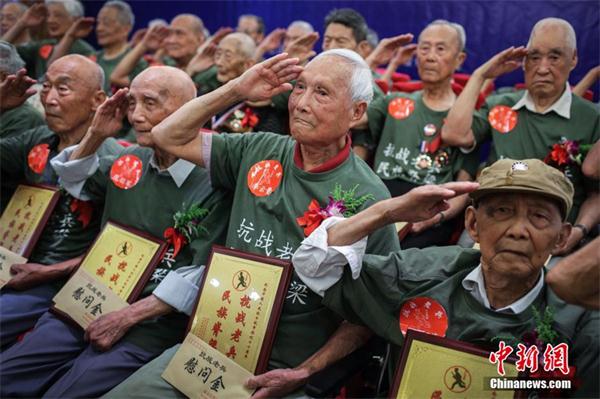Commemorate joint contributions of KMT and CPC
By Wang Jianlang (chinadaily.com.cn) Updated: 2015-07-07 15:35
 |
|
A total of 33 veterans meet to mark the 78th anniversary of the beginning of the War of Resistance against Japanese Aggression in July 7, 1937, in Nanjing, Jiangsu, July 5, 2015. [Photo/chinanews.com] |
The Marco Polo Bridge Incident, or the July 7 Incident in 1937, marks Japan’s full-scale invasion of China and the start of the Chinese People’s War of Resistance against Japanese Aggression (1937-1945). The ultimate victory was won by all Chinese people, and should be jointly commemorated on both sides of the Straits after seven decades.
However, it is noteworthy that some are trying to defame the fight behind enemy lines that was led by the Communist Party of China; showing little respect to the wartime history and an unnecessary obsession with the number of battlefield casualties. Similar unwise voices can also be heard in Taiwan, where a few are sought to discourage Kuomintang veterans from attending the commemorative parade on Sept 3 in Beijing, for the sake of their “health”.
The hard-won triumph of the Chinese People’s War of Resistance Against Japanese Aggression was the first overall victory against outside invasion in China’s modern history. The anti-Japanese united national front based on cooperation between the then ruling KMT and the CPC, played a central role in winning the struggle.
After the Marco Polo Bridge Incident, it was the CPC that pushed hard for cooperation with the KMT to fight the Japanese troops, despite their decade-long civil war. The victory in 1945 belongs to the entire Chinese people, regardless of their party, and arguing over the contributions made by the CPC and KMT during that period does nothing to help the present situation.
Disconnecting the two battlefields and separating their historical contributions may be an attempt to worsen the current ties between the CPC and the KMT, and generate tensions across the Straits. However, the truth is, the frontline battles and the ones behind enemy lines were interdependent, and the two forces supported each other throughout the eight-year war.
True, the KMT-led army as the country’s major military force was sent to engage the Japanese in the frontline, yet they failed to resist the ferocious attacks launched by Japanese troops, who later occupied large swathes of Chinese soil. The CPC guerrillas, however, infiltrated behind enemy lines and established a number of bases that effectively prevented the full might of the Japanese from being deployed against the KMT forces: Over half of the Japanese forces and almost all the troops of the puppet “Manchurian State” established by the Japanese in Northeast China, were engaged with fighting the CPC.
Therefore, it is no exaggeration to say the KMT-led frontline battles would have been even more arduous and without the CPC’s guerilla resistance behind enemy lines. Hence the CPC’s role during the war should by no means be deemed insignificant when comparing casualty numbers.
The well-equipped KMT army had more than 1.7 million soldiers when the war broke out, while the CPC-led Red Army had less than 50,000 and the number of guerrillas in South China was just over 10,000. It is understandable that the two armies fought differently given the vast gap in equipment and personnel between them.
Also, it should be borne in mind that although some of the casualty figures are not accurate, it is estimated that there were about 850,000 Japanese casualties in the frontline battlefield with the KMT army and about 500,000 as a result of CPC resistance — a praiseworthy achievement for the CPC army given all the hardships it had to go through.
Of course, the Red Army’s achievements came at a considerable cost in terms of its own casualties, including the 340,000 of the Eighth Route Army, nearly 700 of whom ranked above regimental commander. It was this commitment to fighting the Japanese forces for the sake of China’s destiny that brought the CPC all the public trust and support it acquired.
With the number of its regular troops reaching 1.3 million and its militia over 2.6 million by the end of the war, the CPC which led around 100 million people in an area of 1 million square kilometers, had begun to play a leading role in the country as victory against the Japanese approached.
The series of high-profile activities to commemorate the victory in both the mainland and Taiwan show the Chinese people have learned an important lesson from the war: that national solidarity brought us the final triumph, and is still needed today.
The author is a senior researcher and director of the Institute of Modern History Studies, Chinese Academy of Social Sciences.

I’ve lived in China for quite a considerable time including my graduate school years, travelled and worked in a few cities and still choose my destination taking into consideration the density of smog or PM2.5 particulate matter in the region.











